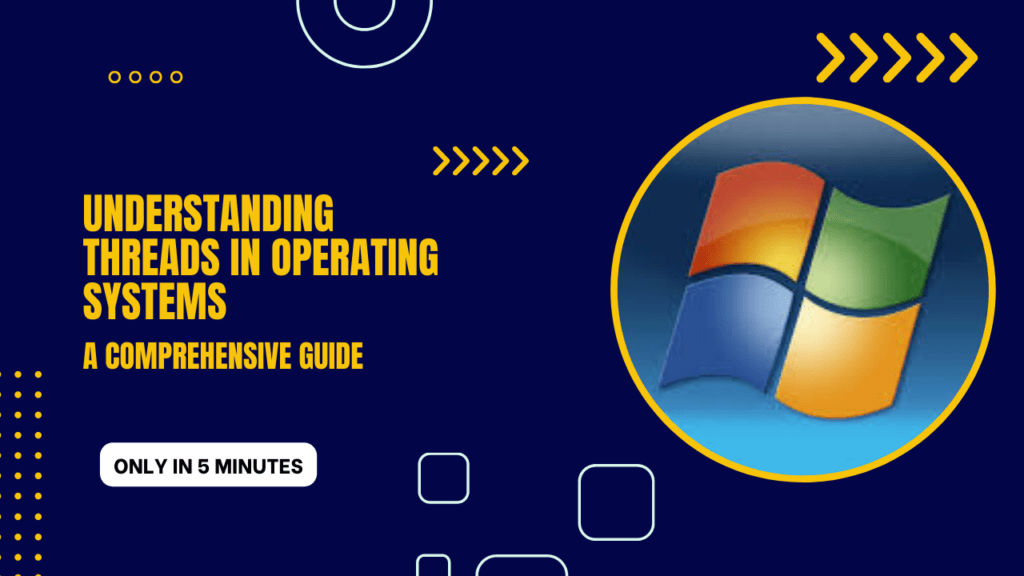Definition of Threads
In operating systems, a thread refers to a single sequence of instructions that can be executed independently. Unlike a process, which is a self-contained unit with its own memory space and resources, threads share resources and memory with other threads within the same process.
Threads vs. Processes
Threads and processes serve different purposes in computing. Processes are independent entities that contain their execution context, while threads are part of a process and share the same execution context. Threads are more lightweight than processes and can communicate more efficiently.
How Threads Work
Thread Creation
Threads are created by the operating system or the application itself. The process of creating a thread involves allocating a new thread structure and assigning it a unique identifier. Once created, the thread can start executing its instructions.
Thread Synchronization
Synchronization is crucial in multithreaded environments to prevent conflicts and ensure proper execution. Techniques like locks, semaphores, and barriers are used to synchronize threads and avoid race conditions.
Thread Termination
Threads can terminate either voluntarily or involuntarily. Voluntary termination occurs when a thread completes its task, while involuntary termination happens due to errors or abnormal conditions.
Types of Threading Models
User-Level Threads
User-level threads are managed by user-space libraries or the application itself. The operating system is unaware of these threads, making them more flexible but less efficient for parallel execution.
Kernel-Level Threads
Kernel-level threads are directly managed by the operating system. They offer better parallelism and are suitable for applications requiring high levels of concurrency.
Hybrid Threading
Hybrid threading combines user- and kernel-level threads, leveraging the benefits of both approaches.
Thread States and Lifecycle
Running State
A thread is running when it is actively executing its instructions.
Blocked State
A thread enters the blocked state while waiting for a resource or an event before it can continue executing.
Ready State
In the ready state, a thread is eligible for execution but is waiting for the CPU to be available.
Benefits of Multithreading
Improved Responsiveness
Multithreading allows for responsive applications as multiple tasks run concurrently, ensuring smoother user experiences.
Enhanced Resource Sharing
Threads in the same process can share resources, reducing memory overhead and improving efficiency.
Efficient CPU Utilization
The CPU can execute tasks more efficiently using idle processing time by utilizing multiple threads.
Challenges and Considerations
Thread Synchronization Issues
Synchronizing threads to avoid conflicts can be complex and may lead to performance bottlenecks.
Deadlocks and Starvation
Improper synchronization can lead to deadlocks, where threads are stuck waiting for each other indefinitely.
Performance Overhead
Creating and managing threads incurs overhead, which can impact performance if not carefully managed.
Multithreading in Real-World Applications
Multithreading in Web Servers
Web servers often use multithreading to handle multiple client requests simultaneously.
Graphics Rendering and Multimedia Applications
Multithreading is essential in graphics rendering and multimedia applications to process large amounts of data in real time.
Scientific Simulations
Complex scientific simulations can benefit from multithreading to speed up computation.
Thread Safety and Best Practices
Avoiding Race Conditions
Race conditions occur when multiple threads access shared data simultaneously, leading to unpredictable behavior.
Critical Sections and Locks
Using critical sections and locks helps ensure that only one thread can access shared resources at a time thread-Safe Data Structures
Choosing thread-safe data structures is crucial to prevent data corruption and inconsistencies.
Comparison with Multiprocessing
Pros and Cons of Threads vs. Processes
Threads are more lightweight and have lower overhead, while processes offer better isolation and fault tolerance.
Choosing the Right Model for the Task
The choice between threads and processes depends on the application’s specific requirements.
Scalability and Parallelism
Parallel Computing with Threads
Threads enable parallel computing, dividing tasks into smaller units for efficient execution.
Amdahl’s Law and Gustafson’s Law
Amdahl’s Law and Gustafson’s Law provide insights into the limitations and benefits of parallel computing.
Thread-Level Parallelism in CPUs
Simultaneous Multithreading (S.M.T.)
SMT allows multiple threads to be executed on a single CPU core simultaneously.
Hyper-Threading Technology (HTT)
HTT, Intel’s implementation of SMT, enhances CPU performance by enabling simultaneous execution of multiple threads.
Future Trends in Threading
Advancements in Hardware Support
Hardware advancements will likely improve multithreading performance and efficiency.
Threading in Cloud Computing
As cloud computing evolves, multithreading will play a vital role in optimizing resource utilization.
Conclusion
In conclusion, threads are a powerful tool in modern operating systems that enable parallel execution of tasks. Threads have become an essential element of efficient computing by improving responsiveness, resource sharing, and CPU utilization. As hardware and software evolve, multithreading will continue to play a significant role in shaping the future of computing.
F.A.Q.s
What is the difference between a thread and a process?
A thread is a single sequence of instructions within a process that can be executed independently. In contrast, a process is a self-contained unit with its own memory space and resources.
How are threads created?
Threads can be created by the operating system or the application itself by allocating a new thread structure and a unique identifier.
What is thread synchronization, and why is it important?
Thread synchronization ensures that threads access shared resources orderly, avoiding conflicts and race conditions.
Can threads lead to deadlocks?
Yes, improper thread synchronization can lead to deadlocks, where threads are stuck waiting for each other indefinitely.
Which is better for parallelism: threads or processes?
Threads are generally more lightweight and efficient for parallel execution compared to processes. However, the choice depends on the specific requirements of the application.



